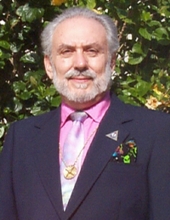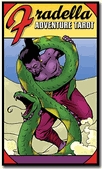|
Tarot Reflections |
|
October 01, 2003 |
|
Deck Review:
Fradella Adventure Tarot Robert E. Mueller, CPTR |
||||||
|
U.S. Games has done it again. They have produced a beautifully illustrated Tarot deck of 78 cards and 146-page book set with a wonderful extra, a full-sized (17-inch by 23-inch) full color Celtic Cross Spread fold-out sheet. The sheet shows how to lay out the spread in detail and explains what a preponderance of cards from any suit or Major Arcana of the Fradella Adventure Tarot might mean. The Tarot cards are a 4 ¾” x 2 ¾.” The backs illustrate a Fradella monogram with reversed letters combined so it will not give away the upright or reversed position of card. The black and white illustrations of the Major Arcana in the book are oversized (a great idea) so you can see the detail that is so important in reading about the cards. The Major and Minor Arcana are illustrated by J. P. Dupras, an award winning artist, with 72 heroes/villains (a couple are repeated) from Frank Fradella’s iHero™ Universe. So many wonderful characters, so little time; however, each is a treat, and they are all worth taking the time to read about and reflect on them, their place in the deck and the archetypal world, and how we see them as part of our lives. Fradella’s heroes are concisely described, powerfully and beautifully illustrated. They expose you to a new style of modern mythology. They represent “a world of people and powers, costumes and conflict.” “The simple fact is that we tell stories about people,” Fradella writes. “They just happen to be people with superpowers, or people who wear costumes. But people nevertheless. “It’s that humanity in our characters that makes them such ideal candidates for representation on the tarot,” he says. “They have the same basic needs and worries as you and I. The same joys and fears. And that goes for the villains, too. You won’t find any cardboard stereotypes in our bad guys. Just normal people whose greed or anger gets the better of them.” For each of the cards, Fradella has created a short description, almost like a short O’Henry-like story. For instance, for The Hierophant, whom he depicts as a man with swan wings, called The Swan, Fradella says, “The Swan stands on the steps of City Hall in Lake Andersen, holding the keys to the city that the Mayor gave him moments before. At the foot of the stairs, reporters listen intently for anything the feathered do-gooder might say. The Swan has just rescued a few teenagers from their own folly as they attempted to drive their car over the frozen surface of the town’s namesake.” For the remainder of the story, well, you’ll have to get the deck and book. |
|||||
|
What’s in a name? Mystery, power, and maybe a bit of a hint of who we are or who we might want to be. Fradella’s names and descriptions of his characters offer us a thumbnail sketch of the personality and attributes of the hero/villain who rules each card. His descriptions stir an inner calling and recognition of the talents and powers we all hope we would find somewhere in ourselves. His heroes have names like Pulsar, The Magician; Etheria, The High Priestess; Aura, the Empress; and, despite his angelic appearance, a villain named Monarch as Temperance. Their names create an atmosphere and feeling for these characters even before you meet them. The name I fell in love with as soon as I read it was Prophecy, for The Hermit. It forced me into a new and different perspective of the card. Fradella describes the essence of The Hermit as “. . . a soul apart from others, but willing to offer guidance. . . . He has learned the most important lesson of all—that the only future with no doubt is the one you create.” The Hanged Man (otherwise known as Eclipse, a misfit) tells you where The Fool has come from. “Here, at last, The Fool has earned a rest from his endless journey, this is a time for inaction, where the events that The Fool has put into motion will yield their fruit. In regards to the Justice card before this one, The Hanged man could be viewed as waiting for a verdict to be returned.” The last Major Arcana, The World, depicts a beautiful women, “whirling in mystic energy.” She is the “the most powerful sorceress in the world.” Fradella goes on to explain his understanding of the card. “Like Solitaire, [her name] The World is not about simply having such power, or wealth, or happiness, but rather the culmination of having earned all of those things.” Fradella says the last key “represents a life well lived, a journey well traveled. The World is all we have ever hoped to become. And we have achieved it by using skill and willpower, opposing the sometimes-cruel twists of fate and the folly of our own judgment.” For me, the depth of insight and intuition of any Tarot deck lies in the Major Arcana; however, some wonderful surprises come from the cards of the Minor Arcana of Fradella’s deck. Wands are now Staves, “a common tool for the modern crime fighter.” Cups are Masks, because they convey or contain emotions. Swords are now Blades, “for obvious reasons, and finally, Pentacles have become Disks, as the concept of currency expands to incorporate information in the digital age.” The Minor Arcana are as powerfully drawn as the Major Arcana with their own meanings, which follow the stories of the deck’s heroes through their interactions with the Minor Arcana cards. For instance, the Seven of Masks (Seven of Cups) shows the hero, with his back to us. Seven different masks emerge from clouds of energy. Fradella says of the card, “Dressed in black and gold, Dreamweaver exorcises his powers of illusion to manifest the seven masks that dance before him. Each one comes from a different culture, representing different aspects of both the illusion and its creator. “This is a representation of an imagination that has been given too much rein. Dreamweaver may soon discover that the Seven of Masks indicates his powers are spread too thin, and deceptions are the order of the day.” How’s that for a different picture and explanation of the Seven of Cups? The chapter “Reading for Yourself and Others” has many treasures in it. Fradella writes in his subsections “Care And Handling” and “Shuffling, Cutting, and Dealing the Cards” clear, simple, and easy directions for understanding these processes. I applaud him for raising awareness about ethics and Tarot card readings, i.e., “. . .there exists a certain code of ethics that every tarot reader should adopt. When a person sits across from you and looks to you for guidance, they’re seeking enlightenment on their own life’s journey.” Fradella then goes into detail about his own ethics and has impressed me so much with his concise and clear understanding of Tarot ethics that I am now including some of them it in my own personal code of ethics and crediting Frank Fradella for the great thought and insight that went into them. Two readings truly illustrate how Fradella’s cards can be read and the interpretations/understanding gained from them. The reading for “Paul,” using the Celtic Cross spread, gives good insight into the meaning of each card in the position it occupies. The reading for “Amy” is a three-card Past/Present/Future spread. Again Fradella gives more details for understanding how to read his cards. So, what started as a lark purchase for me soon became an eagle’s treasure with its own colorful and different wings that flies higher and wider than many other decks I have seen. The Fradella Adventure Tarot is a surprisingly beautifully illustrated, powerful deck employing hero-style crime fighting adventure drawings, an entirely new and unique set of archetypal characters. I happily add this deck to my 300-plus Tarot deck collection. I intend to keep it handy for the new insights it can provide me into the Tarot cards.
|
||||||
|
Subscribe to Tarot Reflections, and receive notification of each update! |
|
Request to be added to the list by sending email to TarotReflections-subscribe@yahoogroups.com! |
All articles remain the
property of their respective authors.
Tarot Reflections is a publication of the American Tarot Association
- Copyright (C) 2003
Questions or Comments? Contact Us.


